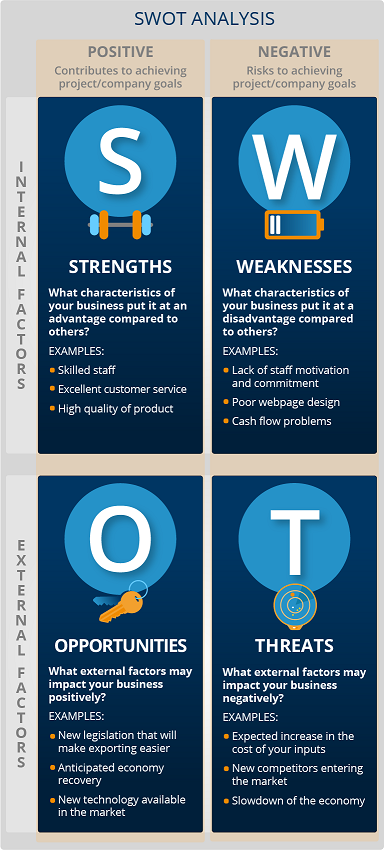Provided by the International Finance Corporation

For your business to thrive, it is important to have a clear strategy in place; but sometimes it is hard to know where to start. Conducting an analysis of your company’s strengths, weaknesses, opportunities and threats may be a very helpful tool to get your business on track. This is called a SWOT analysis.
SWOT analysis is a simple, yet a very valuable technique developed to help companies look at their internal and external issues, and identify available opportunities or overcome existing obstacles to achieve a certain objective.
Strengths and Weaknesses refer to your company’s internal factors (tangible or intangible) that are within your organization’s control. Opportunities and Threats refer to your company’s business environment, and they are out of your company’s control. This is why SWOT analysis is often referred to as Internal–External analysis. Opportunities and Threats may be current or future (e.g. new legislation expected to be passed). It often seems that there is not much you can do to prevent these external factors from harming your business, but being proactive and watching for potential threats can prepare you to tackle them as they arise.
Conducting your SWOT analysis may be time-consuming. You should take a good look at each of the four parts of the analysis and ask realistic and demanding questions to get a good grasp of where you stand in relation to them.
The following are the steps needed to conduct a SWOT Analysis:
STEP 1. DEFINE THE NEED FOR THE SWOT ANALYSIS
A SWOT analysis begins by defining what you want to analyze and determining the specific objectives or goals you want to achieve. Are you analyzing a specific project or your company as a whole?
STEP 2. COMPLETE THE SWOT
The second step is filling a SWOT chart. To begin, draw a four square table where you can list the strengths and weaknesses, opportunities and threats like the matrix below:
a) Determine Strengths
Start looking at your strengths by asking some relevant questions, such as:
- What do you do better than your competition?
- What resources are available to you that put you ahead of your strongest competitor? (team spirit, powerful network, skills, access to advanced technology, etc.)
- What do your competitors see as your strength?
- What is your Unique Selling Proposition?
- Are there other unique company assets that put you at an advantage? What are they?
b) Determine Weaknesses
Start looking at your weaknesses by asking some relevant questions, such as:
- What do you see as your main obstacles that prevent you from accomplishing your objectives?
- What can you improve to get you one step closer to reaching your goals?
- Is your business poorly located?
- What do others see as your main weakness?
- What are the things that are hurting your sales?
- Does your staff need motivation to improve performance?
c) Determine Opportunities
Start looking at your opportunities by asking some relevant questions, such as:
- Are you aware of any market developments that you could use to your advantage?
- Are there certain government policy changes from which your business could benefit?
- Are there any local events where opportunities may present themselves?
- Are there areas where your competitor may be vulnerable where you can thrive?
- Are you careful with your timing when an opportunity presents itself?
d) Determine Threats
Start looking at your threats by asking some relevant questions, such as:
- Could certain strengths of your competitors place your company at risk?
- Are there any technological trends or lifestyle changes that negatively influence your sales?
- Do any of your weaknesses pose a potential threat to your company?
- Have new competitors emerged in the market? What are they doing differently?
- Is seasonality a concern for your business?
Feel free to adapt the questions as they apply to your business circumstances.
A SWOT analysis will be more comprehensive as more people from your company take part and contribute to the process. You could, for example, organize a brain-storming session to complete the SWOT.
STEP 3. PRIORITIZE, STRATEGIZE AND TAKE ACTION
Once the table has been completed, prioritize which strengths, weaknesses, opportunities and threats are critical for your business, strategize on how to address them, and then take action on your plan.
- Strengths. Think about how your strengths help reach your objectives and how you can maintain and use them more effectively. Leverage existing strengths to take advantage of the opportunities and reduce probability of threats.
- Weaknesses. Prioritize which weaknesses to address and when. Then, determine a plan for overcoming/eliminating them, including assigning any needed resources (time, funds, people, training).
- Opportunities. Decide on how to capitalize on opportunities using your strengths. Prioritize which opportunities you want to pursue first and assign any needed resources.
- Threats. Make a plan on how to minimize, manage or avoid the effect of threats to your business.
Maximizing your strengths and opportunities and minimizing the weaknesses and threats that your organization faces allows your business to become more competitive. Additionally, as you complete your SWOT analysis, you will have a solid foundation for crafting your company’s strategic plan.
Copyright © 2000 – 2017, International Finance Corporation. All Rights Reserved.
2121 Pennsylvania Avenue, N.W., Washington, D.C. 20433, www.ifc.org
The material in this work is copyrighted. Copying and/or transmitting portions or all of this work without permission may be a violation of applicable law. IFC does not guarantee the accuracy, reliability or completeness of the content included in this work, or for the conclusions or judgments described herein, and accepts no responsibility or liability for any omissions or errors (including, without limitation, typographical errors and technical errors) in the content whatsoever or for reliance thereon.









